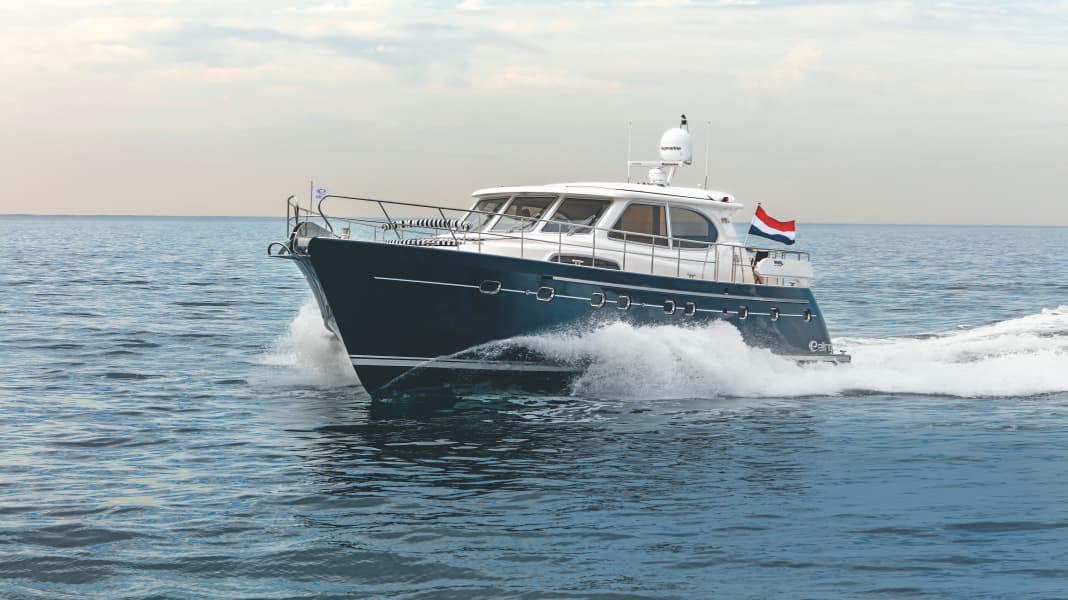
Elling boats are something special, their inventor Anton van den Bos deliberately designed them for travelling at sea. This does not just mean coastal regions, but journeys such as across the English Channel or even the long journey across the Atlantic.
To ensure that the latest development, the Elling E6, can easily cope with this, the shipyard boss has the hull made of Kevlar - a material that is also used in the manufacture of bulletproof vests. When you come on board, you generally get the feeling that everything is built solidly, cleanly and safely.
The high-gloss lacquered surfaces, for example, contribute to this. Van den Bos:
"In order to always achieve an optimum result, we paint over every gelcoat."
The same picture can be seen below deck with the furniture and panelling as well as the (almost) completely painted interior of the hull. Care is also taken in the engine compartment. The cables, pipes and hoses are neatly bundled or in protective tubes.
The electrical system is clearly wired, and the fuel system - with double screwed hose connections and double fuel filter system with drain tap and pressure gauge (for checking filters and lines) and a day tank to protect the main tank from bacteria and the like - offers a good standard.
However, it is not only the installations that make a positive impression, but the entire drive concept is well thought out. The main drive consists of an electronically controlled Volvo Penta D13 with 900 hp, and a Volvo Penta D2 with 75 hp was installed as an auxiliary engine.
The most important aspect of the latter is the mechanical operation and control. The shipyard boss has placed particular emphasis on this - because if, for example, a lightning strike paralyses the electronics of the main engine, the mechanical D2 will continue to chug along.
In addition, the auxiliary diesel has its own 200-litre tank so that clean fuel is available for an emergency trip even in the event of a diesel spill in the main tanks. With the auxiliary diesel, we still reached a top speed of around 7 knots. An emergency steering system is also available.
If you push the lever of the main engine all the way forwards, we travel at a good 20 knots on the North Sea (between IJmuiden and Scheveningen). The noise level of 67 dB(A) at the helm remains within a comfortable range. It must be clear that you are not exactly travelling economically.
A good 7 l/sm run through the fuel line, and only thanks to the huge 5000-litre diesel tank system is it possible to travel 602 nm (plus 15% reserve). The shipyard specifies a long-distance speed of around 9 kn; consumption is then around 2 l/sm, andthis results in 2225 nm plus reserve - a range that Anton van den Bos wants to "test" himself soon with a trip across the Atlantic.
The owner of our test boat had a seakeeper installed to ensure that the journey was as smooth as possible. On the test day (wind force 2 to 3), we only had to deal with a moderate swell. After switching off the stabilisation system, slightly stronger rocking movements were noticeable.
The same applies when cornering at speed, where the boat leans slightly on the outside of the turn and then swings into its own wave.
The Elling shows good course stability both at slow speed and at higher speeds. If you want to make things really easy for yourself, switch on the autopilot and just keep an eye out. This works almost as well at high speed as at displacement speed, as the bow only lifts moderately.
The view aft is only adequate due to the closed lower rear wall. Even longer trips should not be too uncomfortable for the skipper, which is why our test boat has a kind of pilot's seat that can be adjusted in all directions and offers excellent padding and plenty of lateral support.
The co-pilot enjoys the same level of comfort right next to the driver. The driver has just as good a view of the touchscreen monitors as through the windscreen made of insulating glass, which is kept clean in the rain and splash water by three solid double-arm wipers with a washer system.
To ensure safe movement on board, the shipyard installs solid handrails and railings and provides the steps with non-slip Flexiteak. Bilge and fire extinguishing system? Exemplary!
Life on deck takes place on a seating combination with a bench and free-standing chairs and table; there is also a cosy bench and sun lounger on the foredeck. Below deck, three cabins offer sleeping accommodation for six people, with the aft cabin being reserved for the owner couple.
VIP guests sleep in the bow cabin and the children in the centre cabin (bunk beds are available here). Three heads compartments and the spacious galley with seating area in the lower area and the cosy seating area in the saloon round off the homely atmosphere.







